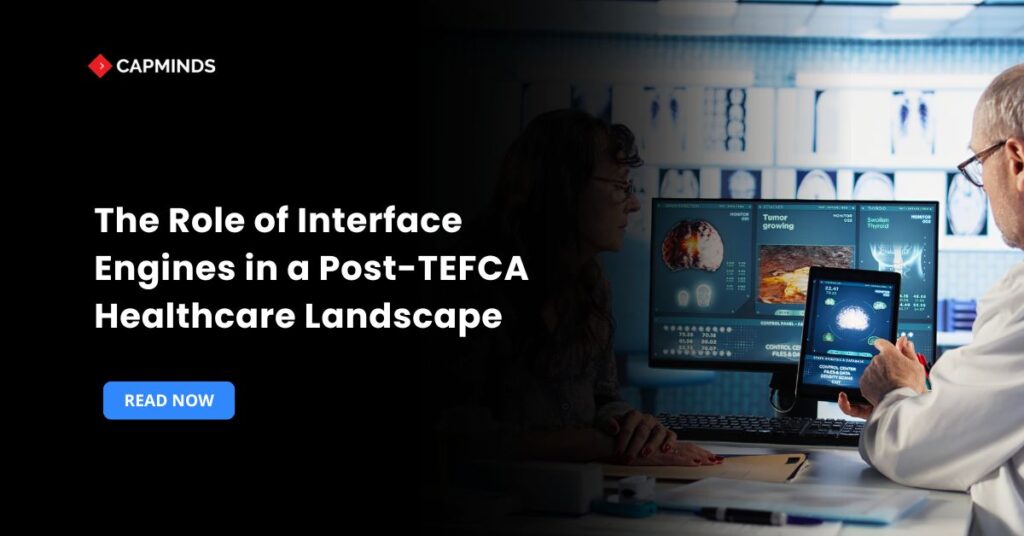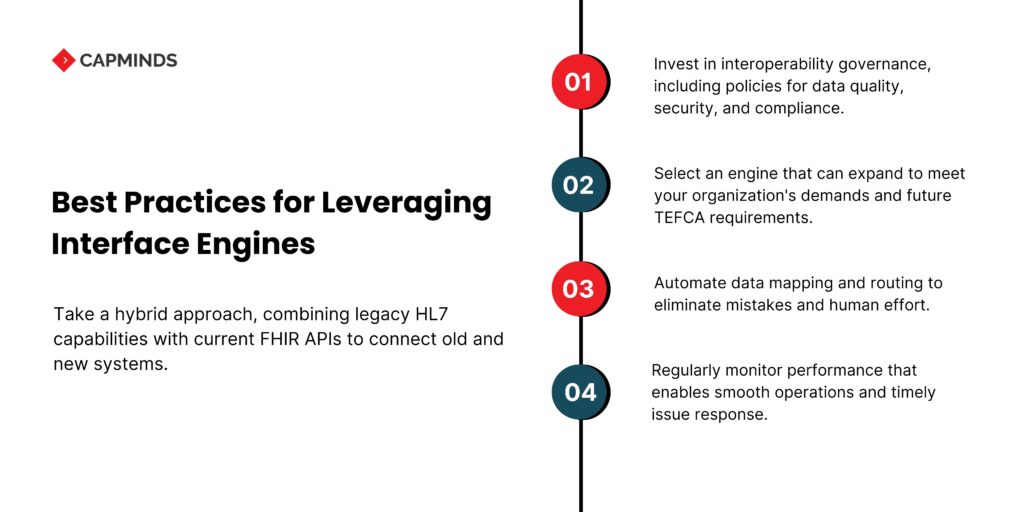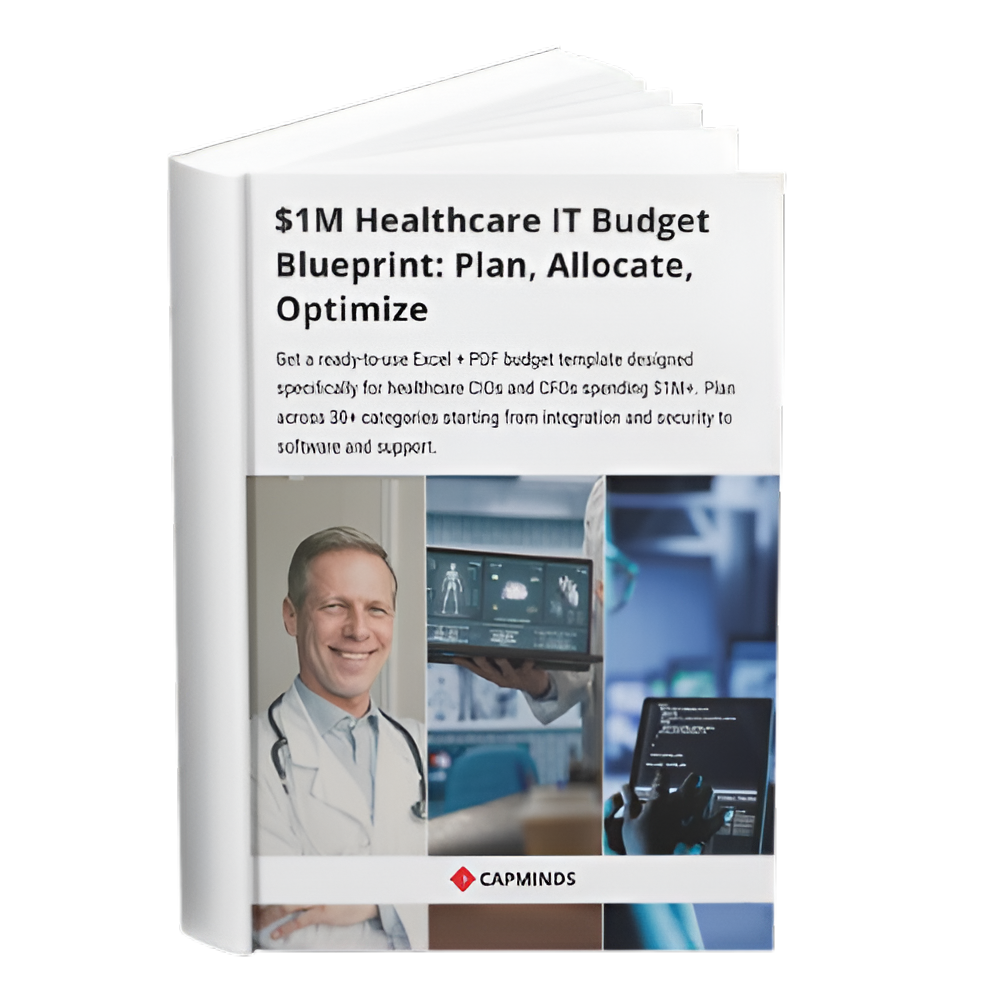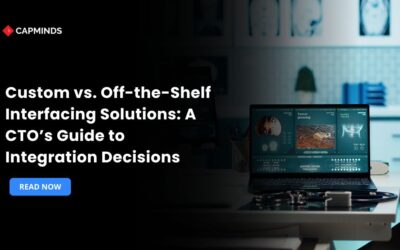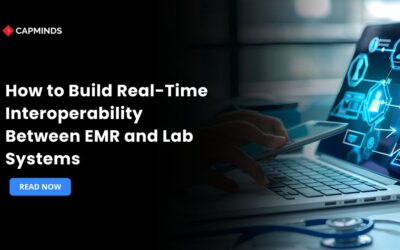The Role of Interface Engines in a Post-TEFCA Healthcare Landscape
Healthcare interoperability is about to change as a result of the TEFCA. TEFCA is a universal framework introduced by the ONC to streamline and standardize data sharing among healthcare institutions. The function of interface engines is more important than ever as we go toward a post-TEFCA era.
Interface engines are more than just integration tools; they enable smooth communication between various healthcare IT systems. These days, they serve as the foundation of interoperability plans, guaranteeing accurate and safe data transfer across intricate networks of payers, providers, and public health organizations.
In this blog, you’ll know what interface engines are, how they work after TEFCA, challenges in implementation, and best practices.
Understanding TEFCA and Its Impact
The goal of TEFCA is to provide a single “on-ramp” for the HIE. TEFCA makes it easier for different healthcare stakeholders to exchange patient data by standardizing data-sharing procedures across Qualified Health Information Networks.
This updated framework gives priority to:
- Ensuring clinical data adheres to a standard format, such as HL7 FHIR, is known as data standardization.
- Security and trust place procedures that allow businesses to confidently share sensitive data.
This implies that current interoperability infrastructures for healthcare companies need to change. How well they can satisfy TEFCA requirements will depend on their capacity to integrate EHRs, legacy systems, and modern cloud-based solutions. Interface engines provide the necessary scalability and agility in this situation.
What are Interface Engines?
Interface engines facilitate seamless data transmission across various healthcare apps by serving as middleware, all without interfering with current operations. They ensure that information stays accurate and useful by managing, translating, and routing data from many sources.
Conventional IT solutions for healthcare frequently function in silos. These silos are connected by an interface engine:
- Translating many data formats, such as FHIR, CDA, and HL7.
- Preserving message integrity while it’s being sent.
- Facilitating instantaneous connectivity across billing platforms, LIS, and EHRs.
Healthcare companies want interface engines that can manage both modern FHIR-based APIs and conventional HL7 communications as TEFCA works to promote interoperability across the country.
The Significance of Interface Engines After TEFCA
The need for standards-compliant and scalable data integration will increase dramatically in the post-TEFCA environment. Companies will have to share patient information between QHINs as well as inside their networks.
Interface engines are essential to this change since:
- Connectivity is made simpler since they serve as a single point of integration, eliminating the necessity of several direct connections across systems.
- Interface engines are compatible with both current and legacy systems since they handle a variety of data formats and protocols.
- Interface engines with integrated monitoring and auditing features aid in preserving adherence to TEFCA regulations as well as other legal requirements, such as HIPAA.
Additionally, by automating data translation and routing, interface engines save operational costs. As a result, healthcare organizations may concentrate on enhancing patient outcomes instead of handling difficult technological issues.
Essential Elements of an Interface Engine for Post-TEFCA
Interface engines need to do more than just provide standard functionality if they are to succeed in the new interoperability era. Important characteristics include:
- Support for FHIR and APIs – For smooth interaction with modern healthcare apps, the engine should completely support FHIR APIs.
- Cloud Readiness – As data exchange volumes increase, cloud-based deployment guarantees scalability and reliability.
- Real-time Monitoring – IT teams can swiftly detect and fix problems with the aid of dashboards and alerts.
- Advanced Security Protocols – To satisfy TEFCA security standards, encryption, access restrictions, and audit trails are crucial.
- Low-code or no-code Configuration – Reliance on IT experts is decreased by using straightforward solutions for data mapping and routing.
These features guarantee excellent data security and quality while enabling healthcare companies to communicate with QHINs and other stakeholders.
Challenges in Implementing Interface Engines After TEFCA
Even with their advantages, interface engines might be difficult to use in a TEFCA-compliant setting. Modern standards like FHIR are frequently incompatible with legacy systems, necessitating the use of extra middleware or custom development.
Typical difficulties consist of:
- Data inconsistency – Interoperability gaps may result from differences in clinical data standards.
- Scalability Problems – The higher data volumes anticipated under TEFCA may be too much for legacy interface engines to manage.
- Cost of Modernization – It might be costly to replace or upgrade antiquated integration infrastructure.
Choosing the appropriate interface engine, investing in knowledgeable integration teams, and exercising cautious planning are all necessary to overcome these obstacles.
Best Practices for Leveraging Interface Engines
Take a hybrid approach, combining legacy HL7 capabilities with current FHIR APIs to connect old and new systems.
- Invest in interoperability governance, including policies for data quality, security, and compliance.
- Select an engine that can expand to meet your organization’s demands and future TEFCA requirements.
- Automate data mapping and routing to eliminate mistakes and human effort.
- Regularly monitor performance that enables smooth operations and timely issue response.
Practical Modernization Roadmap
To prosper post-TEFCA, enhance your interface engine capabilities in gradual, low-risk steps:
1. Take Inventory and Baseline
- List every interface, standard, route owner, and business service that it supports.
- Measure delay, mistake rates, mapping defect rates, and manual touchpoints.
2. Secure, Standardize, and Observe
- Implement an API gateway, centralized authentication like OAuth 2.0/SMART, and secret management.
- Set up schema validation such as FHIR profiles, HL7 v2 compliance, and structured logging.
3. FHIR-first, Event-Driven
- Provide standardized FHIR APIs for internal and partner use.
- Set up an event bus to stream high-value clinical and administrative events.
4. Automate and Optimize
- Implement CI/CD for interface mappings and transformations.
- Use automated regression testing tools for each route modification.
- Add AI-assisted mapping suggestions and anomaly detection for interface testing.
Each step creates demonstrable value while establishing the groundwork for the next. This stepwise strategy decreases migration risk while being consistent with TEFCA deadlines and QHIN onboarding strategies.
Related: How to Align FHIR API Development With USCDI and TEFCA Compliance
Accelerate Post‑TEFCA Interoperability with CapMinds
TEFCA raises the bar for seamless data exchange, CapMinds helps you clear it. Our end‑to‑end digital health tech team modernizes legacy connections, deploys FHIR‑first interfaces, and keeps you compliant while you scale.
From ambulatory practices to multi‑state hospital networks, we’ve engineered thousands of real‑time interfaces that cut claim delays and slash maintenance costs.
- Interface Engine Design & 24/7 Managed Integration
- HL7 v2 ↔ FHIR Mapping, Testing, and CI/CD Automation
- TEFCA Readiness Assessments & QHIN On‑Boarding Support
- Secure Cloud Migration, API Gateways & Zero‑Trust Guardrails
Whether you need rapid route conversions or a ground‑up interoperability strategy, we deliver predictable timelines and measurable ROI. Let’s transform your data pipelines into patient‑centric values.
Certified HL7/FHIR experts and flexible engagement models de‑risk your TEFCA journey from start to sustainable success for your organization.
Contact CapMinds today for a free readiness consultation.
